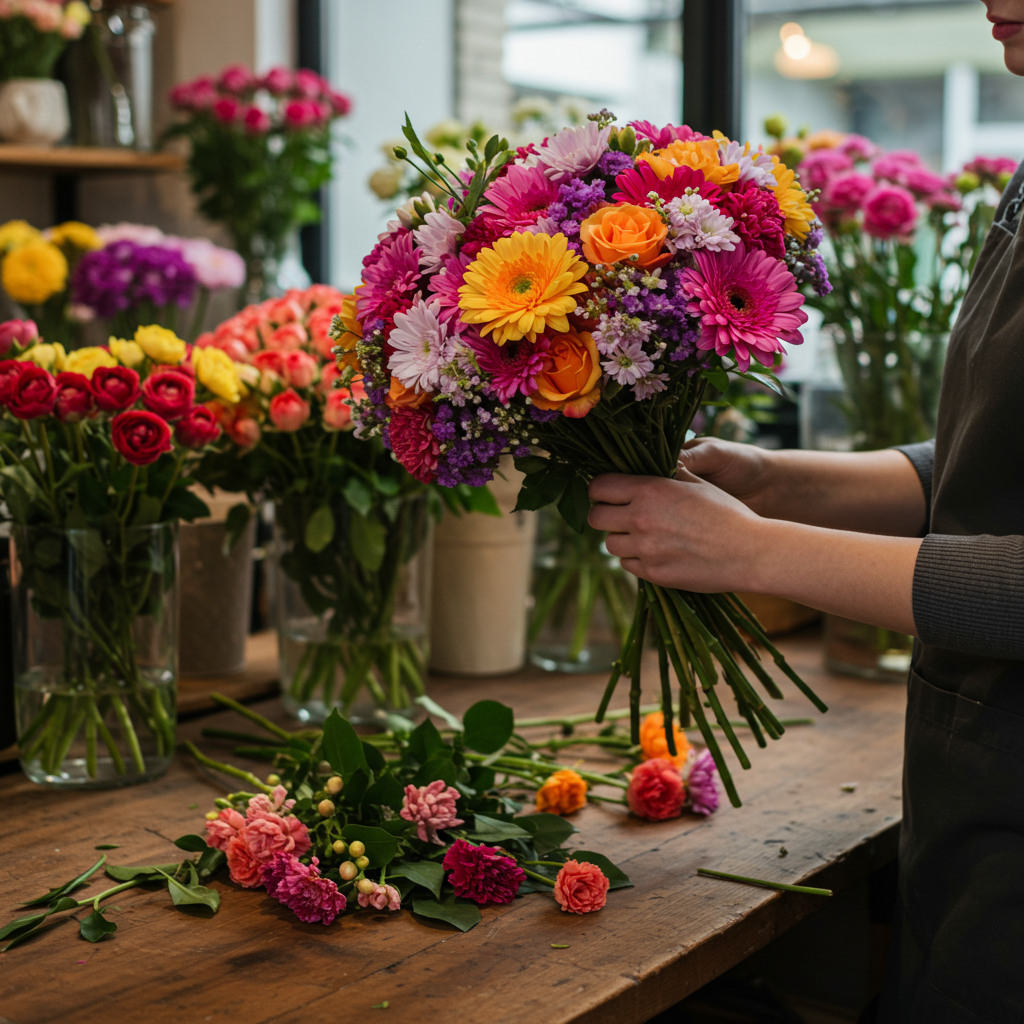
Table of Contents
Introduction
Running a floral business is a beautiful venture filled with creativity, passion, and the joyous task of bringing nature’s elegance into people’s lives. But behind every vibrant bouquet and elegant arrangement lies a world of unique risks and challenges that florists must navigate daily. Have you ever considered what could happen if an unexpected event disrupted your floral shop, risking your investment, employees, and your valued customers? This is precisely why understanding insurance for florists is not just a good idea—it is essential for safeguarding your business and ensuring its continued success.
Florists operate in an environment full of delicate inventory, specialized equipment, and direct interaction with customers, each presenting potential risks that, if unprotected, could lead to significant financial loss. Imagine a sudden flood damaging your flower stock, or a customer experiencing an allergic reaction prompting a liability claim. These scenarios underscore the paramount importance of having the right insurance coverage tailored to the unique needs of a floral business. By proactively protecting your business, you not only shield yourself from financial hardship but also build a strong foundation of trust and professionalism with those you serve.
Understanding the vital role insurance plays for florists begins with grasping the fundamental concepts of coverage and risk management. If you’re new to the topic, starting with insurance basics is invaluable. This foundational knowledge empowers you to make informed decisions about the types of insurance policies most relevant to your floral shop, how they work, and how they can be customized to meet your specific risks. Knowing the essentials prepares you to protect your livelihood effectively and focus confidently on growing your business without unnecessary worries about unforeseen setbacks.
Florists face a distinct set of challenges that make specialized insurance crucial. From property damage caused by fire, theft, or natural disasters to product liability claims arising from allergic reactions or spoiled flowers, the risks are numerous. Employee injuries are another area of concern, as working with sharp tools and heavy deliveries increases the chance of accidents. Moreover, an unexpected closure—whether due to renovations, emergencies, or other disruptions—can halt your income flow, adding further financial stress. Having comprehensive insurance coverage that includes protection against business interruption can be a lifesaver during these times, ensuring your shop can weather the storm and bounce back stronger. You can explore more about business interruption insurance and its benefits to your floral business continuity.
Beyond the practical financial safeguards, insurance offers emotional security. Running a business requires sleepless nights, hard work, and unwavering dedication. Knowing that you have a safety net in place allows you to focus on creativity, customer service, and strategic growth without the constant fear of losing everything due to a mishap. It is this peace of mind that transforms how you perceive risk and manage your daily operations, making insurance a vital partner in your business journey.
What You’ll Learn in This Guide
This guide is designed to provide florists like you with a thorough understanding of insurance tailored specifically to floral businesses. Whether you are just starting out or looking to review your existing coverage, this resource will walk you through the essentials of protecting your shop comprehensively and cost-effectively. Here’s what you can expect to learn:
- Understanding the Risks Unique to Florists: We break down the common hazards and liabilities that florists face, helping you identify the vulnerabilities in your business and why insurance matters.
- Key Types of Insurance Coverage: From general liability to property, workers’ compensation, and product liability insurance, we explain the essential policies florists should consider for full-spectrum protection.
- Choosing the Right Insurance Policies: Learn practical tips for evaluating different insurance providers, comparing coverage limits, understanding exclusions, and balancing cost versus protection to make informed decisions.
- Cost-Saving Strategies and Claims Guidance: Discover ways to reduce insurance premiums through smart practices and comprehensive advice on how to navigate filing claims smoothly if you ever need to.
By the end of this guide, you will be equipped with the knowledge and confidence to choose insurance policies that not only shield your floral business but also support its growth and longevity. You’ll be able to protect your assets, your team, and your reputation in ways that align with your unique business needs and goals.
The journey ahead will delve deeply into each major insurance type with detailed explanations and real-world examples tailored to the florist community. We’ll explore how to assess your risk effectively, negotiate with insurers, and implement best practices that keep your premiums affordable while maximizing your protection. Whether you’re concerned about protecting your storefront, your employees, or your floral products, this guide will provide clear, actionable insights to help you build a resilient insurance plan.
Insurance for florists is not just about policies and premiums; it’s about creating a secure environment where your creativity and business aspirations can flourish. With this comprehensive approach, you will be prepared to face challenges head-on and embrace opportunities that bring your floral vision to life, knowing that your foundation is solid.
As we move forward, keep in mind that the right insurance coverage is an investment in your peace of mind and your business’s future. It enables you to show up day after day with confidence, ready to deliver beauty and joy while knowing you have the protection to handle the unexpected. Let’s embark on this essential journey toward protecting your floral business with the insurance coverage it truly deserves.

Insurance plays a vital role in securing the future of any small business, and florists are no exception. Given the unique nature of the floral industry, florists face distinct risks that require specialized coverage to protect their business, employees, and customers. In the previous introduction, we touched on the importance of insurance for florists. Now, let’s dive deeper into why insurance is essential for floral businesses and explore the types of coverage available. Understanding these factors will empower florists to safeguard their livelihood, minimize financial risks, and ensure continuity regardless of unforeseen events.
Why Florists Need Insurance
Florists encounter a variety of risks that can impact their operations, many of which are unique to their trade. Unlike many other service businesses, florists must manage delicate inventory items that are highly perishable along with a physical storefront that may be susceptible to property damage. On top of that, the business frequently involves customer interactions and deliveries involving vehicles, adding layers of liability. These complexities make insurance coverage not just beneficial but essential for managing potential financial setbacks effectively.
Another reason florists require robust insurance is the legal and financial responsibility to protect their employees. Staff working with tools, handling deliveries, and managing shop equipment face injury risks. Without appropriate coverage like workers’ compensation, business owners could face costly claims out-of-pocket. Additionally, florists often face product liability claims if customers experience allergic reactions or issues related to spoiled floral products. Comprehensive insurance policies help mitigate these liabilities and provide peace of mind so business owners can focus on growing their brand.
Common Risks for Floral Businesses
Let’s explore some major risks florists commonly face to fully appreciate the need for insurance coverage tailored to their specific challenges.
- Property Damage: Florist shops often house valuable floral inventory, refrigeration units, and delicate equipment. Risks such as fire, floods, or theft can cause significant damage and financial loss. Insurance helps cover repairs, replacements, and potential business closure expenses.
- Product Liability: Florists are responsible for ensuring that their products are safe. Allergic reactions to certain flowers, pesticides, or spoiled arrangements can result in claims against the business. Product liability insurance protects against such potential lawsuits and claims.
- Employee Injuries: The use of knives, delivery vehicles, and shop equipment exposes employees to injury risks. Workers’ compensation insurance is crucial to cover medical expenses and lost wages resulting from workplace accidents.
- Loss of Business Income: Unexpected shop closures from damage or external factors such as natural disasters can halt revenue flow. Business interruption insurance provides income replacement to keep the business afloat during recovery.
Types of Insurance Coverage for Florists
Understanding the different types of insurance coverage available is key to building a policy portfolio that fits the unique needs of a floral business. Florists should look for essential policies that cover everyday operations and consider optional coverages to protect against less common but potentially devastating events. Integrating various coverage types ensures comprehensive risk management tailored to the florist’s scale and services.
For those looking to build a solid foundation, it can be helpful to first familiarize themselves with the essential types of insurance that broadly protect businesses. With that groundwork, florists can better decide which policies to prioritize and tailor to their specific operations.
Essential Insurance Policies
The backbone of florist insurance typically includes several key policies that address the core risks discussed above.
- General Liability Insurance: This coverage protects against third-party claims of bodily injury or property damage that occur on the business premises or through its operations. It is critical for customer protection and legal defense support.
- Property Insurance: Protects the physical shop, inventory, equipment, and fixtures against disasters such as fire, theft, or weather-related damage. This insurance helps florists recover quickly by covering repair or replacement costs.
- Workers’ Compensation: Provides benefits to employees injured on the job, covering medical costs and lost wages. It also protects business owners from lawsuits related to workplace injuries.
- Business Interruption Insurance: Offers compensation for lost income and ongoing expenses if the florist shop must close temporarily due to covered incidents. This coverage helps maintain financial stability during recovery periods.
- Product Liability Insurance: Covers claims arising from the use of floral products that cause harm or allergic reactions. This protection is vital given the nature of products handled by florists.
- Commercial Auto Insurance: If the florist uses vehicles for deliveries, this coverage protects against auto-related liabilities, accidents, and damages. It ensures safe business transportation and compliance with laws.
Optional Coverages
In addition to the essentials, florists may also consider additional coverage options that enhance protection against specialized risks.
- Equipment Breakdown Insurance: Florist shops rely on refrigeration and other mechanical equipment, which may be costly to repair or replace after a breakdown. This insurance secures coverage for such unexpected failures.
- Cyber Liability Insurance: As online orders and digital payments become common, florists face cyber risks including data breaches and hacking. Cyber liability insurance helps cover costs from cyber incidents and regulatory penalties.
- Employee Dishonesty Coverage: Protects the business from losses caused by employee theft, fraud, or dishonesty. This option adds a layer of financial security when managing cash and inventory.

Conclusion
Protecting a floral business with insurance is not just a precaution but a vital component of sustainable success. Florists face unique risks such as property damage from fire or floods, product liability concerns due to spoiled flowers or allergic reactions, employee accidents, and financial setbacks from unexpected shop closures. Without the proper insurance coverage, these challenges could lead to significant financial strain or even threaten the survival of the business. This guide has highlighted why insurance tailored to floral businesses is essential, demonstrating how various policies address these specific risks effectively.
The core insurance policies every florist should consider include general liability insurance, property insurance, workers’ compensation, business interruption insurance, product liability insurance, and commercial auto insurance for delivery vehicles. Optional add-ons such as equipment breakdown and cyber liability insurance further bolster protection suited to modern business needs. Deciding on the right coverage requires careful assessment of the shop’s unique risks, comparison of policy limits and exclusions, evaluation of insurer reputation and customer service, and understanding deductible costs. Additionally, managing insurance expenses through safety improvements, bundling policies, and maintaining a clean claims history can significantly reduce premiums while ensuring comprehensive protection.
When unpredictable incidents occur, knowing how and when to file an insurance claim is crucial for timely financial support. Florists should thoroughly document damages, notify their insurer promptly, provide all required documentation, and maintain regular communication until the claim is resolved. This proactive approach helps smooth the claims process, minimizing downtime and enabling a quicker return to business operations. For detailed guidance, exploring resources on the insurance claims process is highly recommended.
To secure your floral shop’s future, take actionable steps now: evaluate your current insurance policies and coverage gaps, consult with a trusted insurance agent who understands the floral industry’s nuances, and schedule annual reviews to keep your insurance aligned with evolving business risks and growth. Learning more about insurance basics can empower you to make informed decisions and confidently navigate your coverage options. Don’t overlook the importance of business interruption insurance, which safeguards your income during unexpected closures and helps maintain continuity when it matters most.
In conclusion, comprehensive florist insurance is an investment in your business’s resilience, peace of mind, and long-term growth. It allows you to focus on creativity, customer service, and expanding your floral vision without the constant worry of financial setbacks from unforeseen events. By thoughtfully selecting and maintaining robust insurance coverage, you establish a secure foundation that lets your passion bloom confidently, supporting your livelihood and the happiness you bring to your community through flowers.
